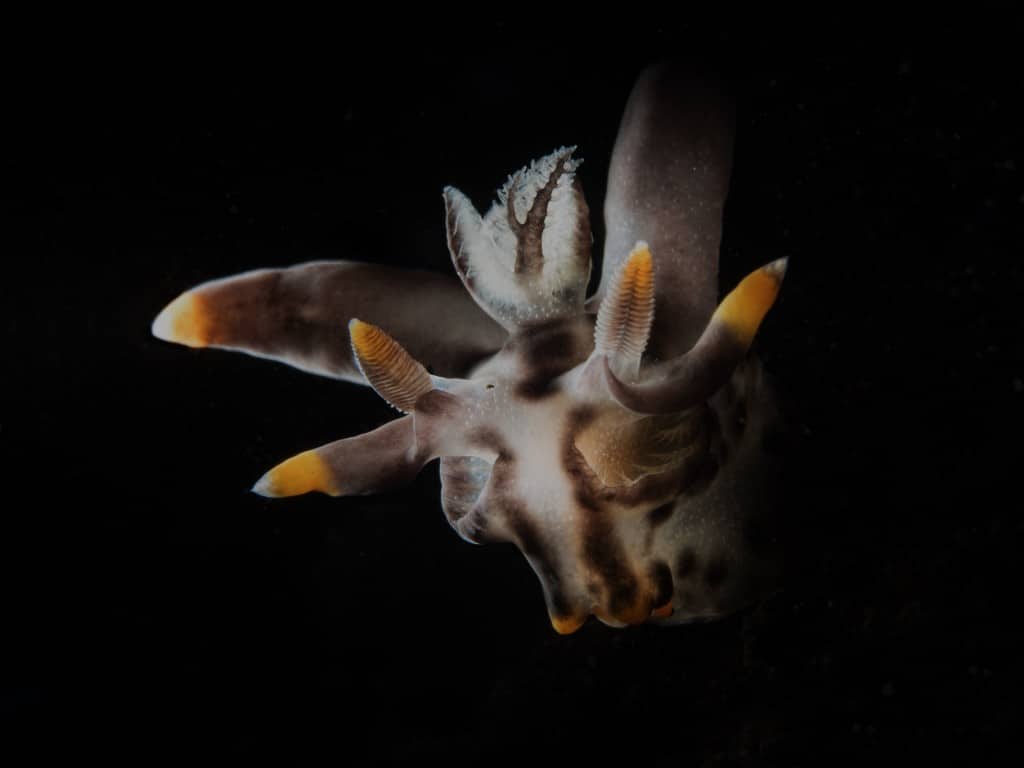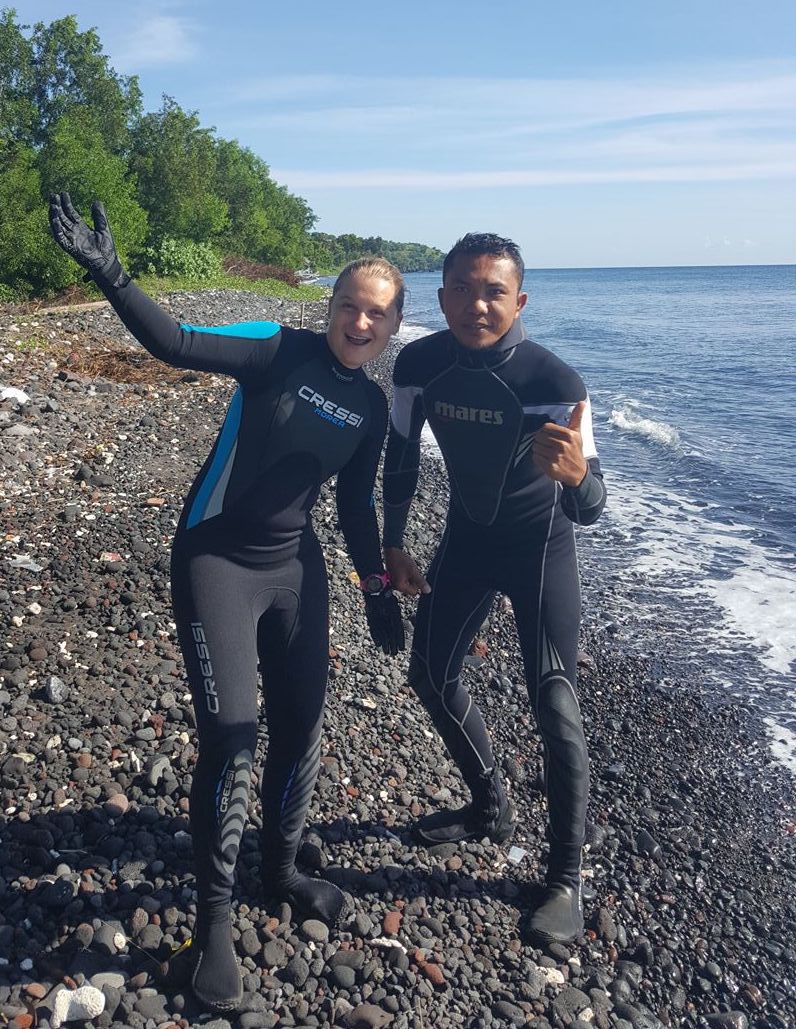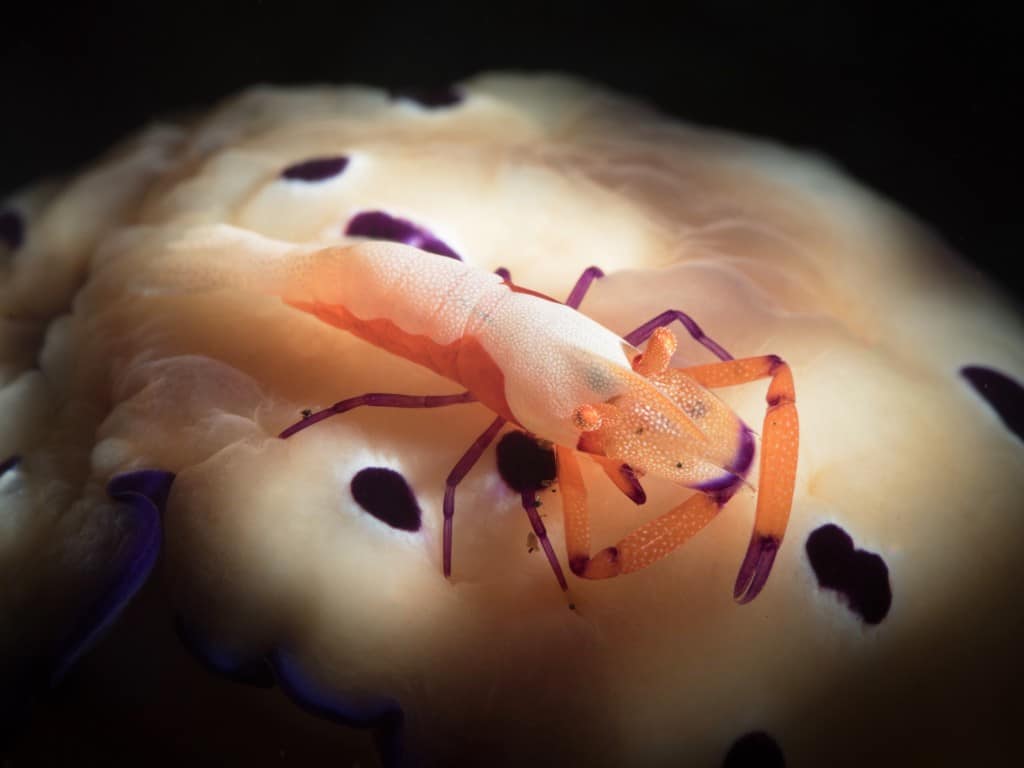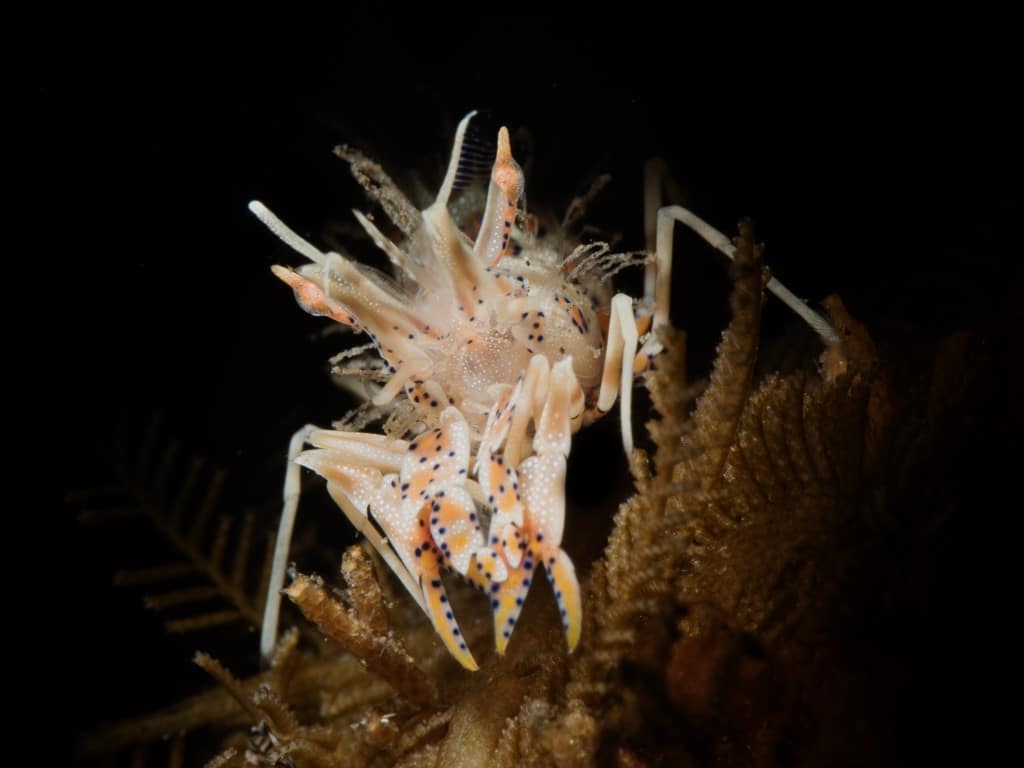Photo / Video News & Reviews
The Art of Snooting

 Are you a black background enthusiast? Do you enjoy playing with the texture and shadows of your subject? Are you looking for a new challenge? If you answered yes to any of these questions, snooting could be the next technique you need to master!
Are you a black background enthusiast? Do you enjoy playing with the texture and shadows of your subject? Are you looking for a new challenge? If you answered yes to any of these questions, snooting could be the next technique you need to master!
For this post I’ve collaborated with Ajiex Dharma, a freelance dive guide and accomplished macro photographer, based out of Tulamben, Bali. Well known for his signature black background photography, Ajiex regularly teaches keen divers the snooting technique. In this blog, we’re going to be talking through the benefits of snooting and some tips and tricks for you to get started.
Before we get started, what is snooting? Usually reserved for shooting macro subjects, snooting is a lighting technique where a tube or funnel is placed over the front of strobe(s), allowing the photographer to direct light onto the subject in a more precise manner. The photographer will typically shoot photographs of this style using a high shutter speed, higher f-stop value and a low ISO. This creates a crisp black background in contrast to the illuminated subject.

A relatively inexpensive technique to try out for yourself, gear ranges from home made ten dollar funnels, through to the more expensive Retra snoot… and everything in between. There really is an option to suit every budget.
I asked Ajiex what he thinks is the benefit of the technique and what a photographer can expect to gain from shooting using snooted lighting in comparison to a less fiddly technique?
“Snooting is a different shape of lighting. It is particularly useful when you enjoy achieving a black background in your photographs. A snoot is really worth the extra effort for isolating a subject where, due to how the subject is located, you can anticipate a messy foreground or bland background. You can make a subject stunning and elevate your photograph from an ID shot to a work of art!” AD
So, let’s get started, these are our top tips and tricks you need to consider when trying your hand at snooting.
1: Get your buoyancy under control
Snooting requires you to get very close to your subject, so as you can imagine, buoyancy is critically important. As a photographer, you want to approach your subject in a calm and controlled manner to prevent your subject from running away or hiding. Creeping up on your subject with minimal disruption to it or the muck and sand around you will save you time editing out backscatter in post. It will also allow you more time with your subject, minimizing any stress you may cause it.
Additionally, like in all underwater photography, the more rapidly you breathe and the more you move, the faster you’re going to run through your air while also introducing motion blur into your image.
2: Know your camera
“Understanding your equipment is really important. It helps you understand what settings you need to get the shot you want. For example, if you shoot a hairy shrimp with a backlight, you need to know how to capture the details. If you use a big f stop (f5), you will get more light but you will probably find your picture is too bright. You will also find this depth of field too shallow. If you use f22 (or higher) this image will be even better because it will be sharp” AD

As with all macro photography, you need to understand the relationship between ISO, Aperture and Shutter Speed. You will still need to evaluate the size of your subject and the effect you want to create. The lighting technique is not a substitute for good macro practices. Make sure the eyes or key features of your subject are sharp and in focus and that you’re shooting with intent.
3: Get a friend to help you
Picture an actor standing on a stage with a spotlight above them. One step in either direction and your actor is in darkness. A snoot performs in much the same way. The beam of light can be so narrow that one centimetre in the wrong direction and your beautiful nudibranch or decorator crab will be in darkness.
Getting a friend or assistant to give you a hand will make getting the hang of snooting initially much easier. Eventually, after a lot of practice, you will get a feel for the new piece of equipment and will develop an understanding of where the snoot needs to be placed in relation to your camera and subject. However, when you’re just starting, doing this on your own will be infuriating. Your friend or buddy will be able to see the subject easily and help you place the light more efficiently onto the subject.
If your strobe has a focus light, use it. It’s so much easier to be able to see a beam of light coming from your strobe before you take the shot. It will give you a much better idea of what features will be illuminated, how the shadows will fall and whether or not your subject will be over or under exposed.
This will be a great help for your buddy initially to get light placement just right. Additionally, when you come to shooting on your own, this will be an invaluable learning aid.
4: Get creative!
“Snooting is about getting creative and using different lighting. Backlighting, side lighting, it’s about drama!” AD
Remember my spotlight analogy from point two? Now forget it! It’s time to get creative. Top down lighting is not your only option. The real benefit of snooting is that you can direct light precisely from any direction imaginable. When you’re first learning, find a single interesting subject and stay with it. Snoot it from the top, the back (particularly if it’s transparent), the sides, underneath and watch how the shadows and the texture of the subject change. Although maybe try and find a subject without eyes that won’t mind being blasted with light over and over again…
As an example, I’ve included an image below of an emperor shrimp on a nudibranch. I’ve seen many of these pics with the shrimp sitting in between the rhinophores lit from the top down. I wanted to do something different. The snoot was placed facing the shrimps face but with the power of my strobe dialled right down.
By doing this, it allowed me to showcase the texture of the nudibranch skin. You can actually see the little feet of the shrimp digging into the surface of the nudibranch. If you keep looking at the images, you can even see the wrinkles and fold of the skin. I thought it was something beautiful and unique, worth capturing.

To show you a different effect, Ajiex and I photographed the Pikachu nudi using a side lighting technique. The snoot was held to the side of the subject, allowing the transparency to become the feature of the photograph. Additionally, by creating highlights and shallows, the folds of the face became far more apparent. I feel like it gave the subject an interesting personality and interest.

As a final tip, when snooting, remember you don’t have to capture the subject in isolation. Sometimes it is interesting to include a little of the background of context. If there is a beautiful tunicate, try and include this in your shot. Really this tip is about playing with your gear and really finding out what you like and the best way to achieve shots that you feel proud of.
Wrapping up, I really hope you’ve got a good sense of what snooting is and some practical tips to help you get stuck in. It’s a technique I absolutely love using. Despite the initial frustrations of learning how to place the snoot and using the power setting on my strobe to get a light balance that I enjoy, it’s been a really worthwhile challenge and I highly recommend that you give it a go!

If you’re ever in the Tulamben area and want to take lessons or learn more about snooting, you can reach Ajiex here on Facebook or Instagram @ajiexdharma.
Check out more of Miranda-Clare’s photos on Instagram @divingphotos or visit her website www.mirandaclare.com.
Blogs
Jeff Goodman Launches Underwater Moviemaker Course with NovoScuba

Transform Your Dive Experiences into Cinematic Masterpieces
NovoScuba has partnered with acclaimed underwater filmmaker Jeff Goodman to introduce the Underwater Moviemaker Course—a revolutionary program designed to equip divers with the skills to capture the breathtaking beauty of the underwater world.
Whether you’re an aspiring filmmaker, an avid diver, or a photography enthusiast, this course offers the tools and expertise needed to create stunning underwater videos. From vibrant coral reefs to curious marine life, you’ll learn how to film, edit, and produce captivating underwater stories, all with expert guidance from a seasoned professional.
Jeff Goodman: A Legacy in Underwater Filmmaking
Jeff Goodman brings over 40 years of experience in underwater film production for television to this course. Reflecting on his career, Jeff said:
“Although technology has dramatically changed, the basics of underwater filming remain constant. This course covers crucial skills for producing great videos. Whether you’re creating professional broadcast films or high-quality hobby videos, the fundamental principles are the same.
A camera operator must master their equipment to capture those magical underwater moments effortlessly. But beyond technical know-how, underwater filmmaking is about having fun and enhancing your diving experiences. So, take your time, learn at your own pace, and enjoy this creative journey.”
About NovoScuba
Founded in 2023, NovoScuba is reshaping dive education with a comprehensive, digitally native platform. Offering cutting-edge training programs for divers at all levels, NovoScuba sets a new benchmark in the diving industry by combining innovation with accessibility.
With ISO-certified courses, a student subscription model, and multilingual support, NovoScuba ensures that dive education is inclusive and engaging. More than just a training provider, NovoScuba fosters a global community of divers committed to exploration, collaboration, and sustainability.
Join the NovoScuba Underwater Moviemaker Course Today!
Dive into the world of underwater filmmaking and start creating cinematic stories that inspire. Learn more about the course and enroll today at www.novoscuba.com/novoscuba-underwater-moviemaker-course.
EXCLUSIVE: Jeff Goodman interviews Mark Spiers, CEO of New Scuba Diving Training Agency NovoScuba
NovoScuba’s Game-Changing Approach for Dive Store Owners: WE PAY YOU!
The diving world thrives on passion and adventure, but for many dive store owners, the financial and operational challenges can be as deep as the ocean.
NovoScuba, an emerging force in the diving world, is on a mission to transform this landscape for the better. With a revolutionary approach to dive store and training agency partnerships, NovoScuba is setting new standards for how dive stores can thrive while keeping their focus on delivering exceptional diving experiences.

A New Paradigm: NovoScuba’s Bold Mission
NovoScuba’s mission is straightforward yet profound: to disrupt the traditional dynamics between dive store owners and training agencies. Traditionally, dive stores have been subjected to substantial fees charged by training agencies, for membership, materials and certifications. These costs have often placed a heavy financial burden on store owners, cutting into their profits and limiting their ability to offer competitive prices to customers.
NovoScuba flips the script by offering a model where dive stores earn money, instead of paying high fees. Dive stores receive commissions for every student they register, and their certification costs are covered. This new model not only boosts profitability but also ensures clients get top-quality training at unbeatable prices.
Financial Upsides: Earn From Student Registration
NovoScuba’s approach is simple yet revolutionary. Dive stores partnering with NovoScuba can earn commissions for every student they enroll.
Here’s how it works: For every student enrolled through NovoScuba, dive stores receive a commission. Each student enrolled will receive their e-learning materials and certification credit included in their subscription. This arrangement is a significant departure from the traditional model, where dive stores often struggle to manage high overhead costs related to training fees and certification expenses.

NovoScuba’s approach ensures that dive stores can focus on what they do best—providing top-notch diving experiences—without being bogged down by excessive financial burdens, and the need to carry large stocks of materials.
Quality Training at a Great Price
NovoScuba stands out by offering high-quality, ISO certified, training that doesn’t break the bank, in fact our students will pay less than with most competing agencies. Clients benefit from top-notch education and safety standards at competitive prices. Dive store owners can confidently promote NovoScuba’s programs, knowing they’re offering fantastic training at affordable rates. This balance of quality and affordability helps dive stores build a strong reputation and attract more customers.
Your Brand is Your Business: NovoScuba’s Commitment to Showcasing Your Identity
At NovoScuba, we understand that your brand is your most valuable asset, and we’re committed to putting it front and centre. Unlike agencies that charge high fees to promote their own brand, we believe in investing in yours. With NovoScuba, you won’t be paying to advertise someone else’s logo alone, — our focus is on showcasing your unique identity. Certifications prominently feature your brand, as well as the training agency, reinforcing your store’s image and brand every step of the way. We’re here to support and elevate your brand, ensuring that your investment directly benefits your business.
Affordable Membership: An Investment in Your Success
NovoScuba’s membership model is designed with dive store owners in mind. Membership fees are kept low and include annual Pro member fees for your team. Payment can be made monthly or annually in your local currency, avoiding the hassle of exchange rate fluctuations. NovoScuba promises no exchange rate changes without a six-month notice, ensuring financial stability and simplifying budgeting. With a membership lasting 12 months from date of joining, you’ll enjoy a full year of NovoScuba’s benefits and support.

Streamlined Operations: Simplifying Your Workload
Handling administrative tasks can be a challenge, but NovoScuba makes it easier. We’ve streamlined certification procedures and reduced paperwork to help dive stores operate more efficiently. Certification processing is quick and straightforward, allowing more focus on teaching and customer service. Our system minimises bureaucracy by storing necessary forms in student profiles, reducing paperwork and administrative delays.
Crossover Made Easy
For dive stores looking to transition to NovoScuba’s model, the crossover process is designed to be smooth and hassle-free. NovoScuba provides support to ensure that the transition is as seamless as possible, helping dive store owners integrate into the new system with minimal disruption. Experienced dive Pros don’t need to undergo extensive retraining. Our crossover is designed to familiarise Pros with NovoScuba’s user-friendly platform, standards and course structures, and not to waste time and expense re-training in water.
With just a few simple steps, you’ll be ready to offer top-notch training through NovoScuba.
Comprehensive Business Support and Training Included in Your Membership
NovoScuba goes beyond financial benefits by offering experienced support and training. This value added service includes:
- Business Training: Optimise your operations with guidance on marketing, customer service, and best practices.
- Marketing and Promotion: Access resources to attract new customers and boost your store’s visibility. Enjoy cross promotions with NovoScuba to gain increased exposure.
- Ongoing Support: NovoScuba’s commitment to its partners extends beyond initial training and setup. The company offers ongoing support to address any issues or questions that arise. This continuous support ensures that dive store owners have a reliable resource to turn to whenever they need assistance.

Embracing Digital Natives: Instant Evolution and Continuous Improvement
NovoScuba’s digital-native approach is a game-changer. Leveraging cutting-edge technology, we ensure our services evolve and improve swiftly. Dive stores benefit from instant updates, the latest features, enhancements, and effective solutions, keeping them ahead of the curve. This continuous improvement helps dive stores stay competitive and deliver exceptional services. Whether it’s a new course update, additional marketing resources, or improved e-learning functions, NovoScuba’s digital infrastructure ensures that dive stores are always equipped with the most current and effective solutions. This continuous evolution not only helps dive stores stay ahead in a competitive market but also ensures they consistently provide top-quality services to their clients.
Why Is NovoScuba Doing This? – Fair Profit Sharing for Greater Access and Growth
At NovoScuba, we’ve taken a bold step by paying commissions to stores rather than following the traditional model of training agencies charging high fees. Our mission is to make diving accessible to everyone and to foster a growing community of new divers and continued education. By redistributing profits more equitably between stores and training agencies, we aim to create a more supportive and collaborative environment within the industry. We believe this approach not only helps individual stores thrive but also stimulates overall growth and innovation in diving. Our commitment to fair profit sharing reflects our dedication to the long-term health and expansion of the diving community.

Everyone is getting a piece of the pie.
Getting Started: Join the NovoScuba Revolution
Ready to revolutionise your dive store experience? NovoScuba is here to support your journey toward reduced costs, increased profitability, and enhanced operational efficiency. Get in touch with our team to learn how NovoScuba can transform your business.
For more information, email info@novoscuba.com or visit www.novoscuba.academy.
Blogs
The Benefits of Underwater Photography Workshops

Are you just getting started out in underwater photography or are you a seasoned shooter who wants to take their images to the next level? Whatever you experience or ability, here’s an overview of underwater photography workshops.
What is an Underwater Photography Workshop?
The first thing to note is that this is not ‘school’! There are no compulsory classes and at workshops you are free to pick and choose what you take part in, or otherwise.
A huge part of learning and developing your skills is through experimentation, trial and error, responding to feedback, and honing your technique. Underwater photography workshops provide you with the perfect platform for practice and improvement.
There is no better alternative to hands on experience in an environment that is 100% dedicated to your development. Reading informative articles and watching videos on YouTube can never replace the value of one on one time with your camera rig, underwater!
Underwater photography workshops are generally structured around core components, namely: presentations, underwater practice, feedback and critique sessions, troubleshooting/one-on-one sessions, and technical support.
Other components of a workshop include dining, relaxing, and time for socializing too!

What Topics do Underwater Photography Workshops Cover?
Depending on the pro, the type of workshop and regional diving highlights, a wide range of topics may be covered from composition and lighting through to shooting techniques and editing.
Benefits of an Underwater Photography Workshop
- Improve Your underwater photography
- Learn from professionals
- Learn from other participants
- Expand your photography knowledge and understanding
- Try put new techniques
- Learn how to maximize your camera rig
- Phenomenal travel opportunities
- Memorable experience and new friendships

Underwater Photography Workshops in the Lembeh Strait, Indonesia
When it comes to underwater photography workshops that focus on shooting macro, muck diving, and unusual marine species, there can be no better destination on the planet than the Lembeh Strait.
The Critter Capital of the World, a Muck Diving Mecca, and the Twilight Zone are just a few of the names that have been given to this stretch of water over the years due to its high density, and diversity, of rare and unusual marine life.
Some of Lembeh’s most iconic species include the hairy frogfish, Pontohi pygmy seahorse, the Lembeh sea dragon, Mandarin fish, Bobbit worms, Rhinopias scorpionfish, flamboyant cuttlefish, tiger and harlequin shrimps, ornate ghost pipefish, harlequin crabs, and where do we start with octopus? Here’s just a few… wunderpus, mimic, blue ring, hairy, long arm, starry night, and coconut… and the list goes on!
Dive conditions in the Lembeh Strait can be extremely favourable for underwater photographers. There is little to no current making both moving around and remaining stationary a breeze. The comfortably warm water temperatures reduce the cold that can also set in when not on the move.
Lembeh Resort and Underwater Photography Workshops
Lembeh Resort not only offers luxury accommodation in the Lembeh Strait but it is also offers a complete suite of facilities for underwater photographers and enthusiasts. Here is a ‘snapshot’ of the camera and imaging services that are on offer at Lembeh Resort – inside and outside of underwater photography workshops:
Photography Facilities
Lembeh Resort offers a suite of facilities for underwater photographers, including:
- The only Backscatter Authorized Photo Center in Asia
- Photo Center offering camera, housing, lights and accessory rentals and purchases, onsite repairs, onsite 3D printing of small components, professional support and assistance, full workshop support
- Full time onsite Photo Pro
- Full time onsite Marine Biologists
- Marine biology and underwater photography trained Dive Guides
- Spacious camera room with individual work spaces, lights, and power points
- Varied diving options including single dives in the Lembeh Strait, two or three tank dive trips, day trips to Bangka, east coast Lembeh trips, blackwater, bonfire, night, and Mandarin fish dives.

Capturing Critters in Lembeh Underwater Photography Workshop 2025
The renowned Capturing Critters in Lembeh Underwater Photography Workshop is back in January 2025 for the 12th year running!! This unique workshop is hosted by not one but three worldclass photo professionals. The 2025 workshop features: Ron Watkins (USA), Paul Duxfield (UK), and Renee Capozzola (USA). The week-long workshop promises to be packed with incredible diving, Pro presentations, and one-on-one instruction and feedback.
2025 Workshop Schedule and Dates:
- Pre-Workshop: January 8th ––10th (time to relax and unwind after traveling and enjoy some of Lembeh’s famous dive sites.)
- Workshop: January 11th – 17th (Capturing Critters in Lembeh 12th Annual Workshop)
- Workshop Extension: January 18th – 19th (Additional Day Workshop Extension)
- Post-Workshop: January 20th – 21st (Stay additional nights and enjoy extra diving days or some time to relax and explore more of North Sulawesi)
Find Out More:
Meet the pros and find out more about the Capturing Critters in Lembeh 2025 underwater photography workshop, including prices and workshop inclusions, here:
If you are ready to book your place on the January 2025 Capturing Critters in Lembeh Underwater Photography Workshop – contact Lembeh Resort at: reservations@LembehResort.com.
-

 News2 months ago
News2 months agoIconic SS United States to become the World’s Largest Artificial Reef
-

 News3 months ago
News3 months agoBook Review – 52 Assignments: Underwater Photography
-

 Gear News3 months ago
Gear News3 months agoDYNAMICNORD – New German diving brand enters the British market
-

 News3 months ago
News3 months agoExploring Cenote El Pit: A Diver’s Dream
-

 Gear News3 months ago
Gear News3 months agoTry BARE drysuits (and maybe even win one!) this Friday with Sea & Sea at North West Dive Fest
-

 Marine Life & Conservation3 months ago
Marine Life & Conservation3 months agoBook Review: Coral Triangle Cameos
-

 Blogs2 months ago
Blogs2 months agoDive the Egyptian Red Sea this Autumn with Regaldive
-

 News3 months ago
News3 months ago2024 Ocean Art Underwater Photo Competition Announced















